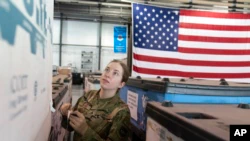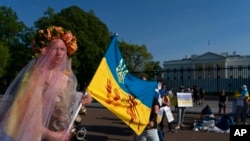As the Russian invasion continues into its third month, Americans are displaying an outpouring of sympathy for Ukrainians and support for Washington’s robust assistance to Kyiv.
Polls show strong bipartisan support for the $33 billion in supplemental funding that U.S. President Joe Biden requested from Congress this week, in addition to a $13.6 billion package of military and humanitarian aid that lawmakers approved last month.
Americans also support Biden’s commitment to admitting Ukrainian refugees into United States and expediting their legal entry process. A Gallup poll conducted April 1-19 showed 78% of Americans approved of “allowing up to 100,000” Ukrainian refugees into the U.S. — the highest level of American public support for admitting refugees that Gallup has found in its polling on various refugee situations since 1939.
The support is widespread across party affiliation, gender, education, income and regions of the country, said Lydia Saad, director of U.S. Social Research at Gallup.
“This is not a controversial issue,” Saad told VOA. “In this very partisan environment, it’s notable that the majority of Republicans agree with the majority [of] Democrats on anything.”
Meanwhile, a Reuters/Ipsos poll this week showed that 73% of Americans support the administration’s efforts to supply Ukraine with weapons, the highest level of support since Russia invaded its neighbor in February.
There is also widespread support for imposing economic sanctions on Russia. And according to a recent poll by The Associated Press-NORC Center for Public Affairs Research, 54% of Americans, mostly Republicans and independents, want Biden to get even tougher with Moscow.
Contributing factors
Some of the reasons for the high level of American sympathy are the rapid escalation of the conflict, the geopolitical implications of a nuclear power attacking a country that shares borders with NATO allies, and the displacement of millions of people in a span of mere months.
Even before the invasion, Americans had a more favorable view toward Ukrainians than Russians in general, as shown in a Gallup poll conducted in February. Many Americans still remember Cold War-era drills in preparation for a Russian nuclear attack, said Michelle Kelso, assistant professor of sociology and international affairs at George Washington University.
“I think it does tap into the historical fear of Russia and the capability of Russia of doing real harm to us,” she told VOA. More recently, Moscow has been seen by Americans — particularly Democrats — as a hostile power that tried to meddle in the 2016 U.S. presidential election in favor of Donald Trump.
The lobbying clout of the more than 1 million Americans of Ukrainian descent across the country also translates to bipartisan support in Congress, resulting in the rapid flow of billions of dollars in military and humanitarian aid to Kyiv. And so might Americans’ affinity for Ukraine as a European and Christian nation.
“There is somewhat of an identity, or an identification, with the background there,” Kelso said. “They’re not black and brown people coming from Afghanistan and Haiti.”
With the exception of support for the Clinton administration’s decision to bring in several hundred ethnic Albanian refugees from Kosovo in 1999, no other refugee appeal has been supported by such a large portion of Americans and so widely across the political spectrum.
“Bringing in refugees from Syria and Honduras and Central America [was] much more partisan,” Saad said. “Democrats [are] much more favorable to those migrants than Republicans. Independents are somewhere in between.”
Other influences
The disparity between support for Ukrainians and support for other groups may also be influenced by the circumstances the groups are fleeing. While Ukraine is under attack by a much larger outside power, Syria and Central American countries are seen as nations dealing with their own internal issues — whether it’s a ruthless dictator or a corrupt government incapable in dealing with poverty and gang violence. The circumstances in those countries are much harder for Americans to digest than the situation in Ukraine, where the plot is simple, and the villain is clear.
“There’s not one person at the top of the pyramid, where you’re saying, ‘OK, if we just take this person out, everything else will fall into place,’ ” Kelso said. Thus, in the context of the Russian invasion, the principle of sovereignty is easier for Americans to understand and defend than it is in the more convoluted conflicts in the Middle East that have dragged on for decades.
The image of a young and charismatic leader courageously leading his country in a time of war has also galvanized support, Kelso said. Ukrainian President Volodymyr Zelenskyy “is, for us, an underdog. We love the underdog in this country.”


